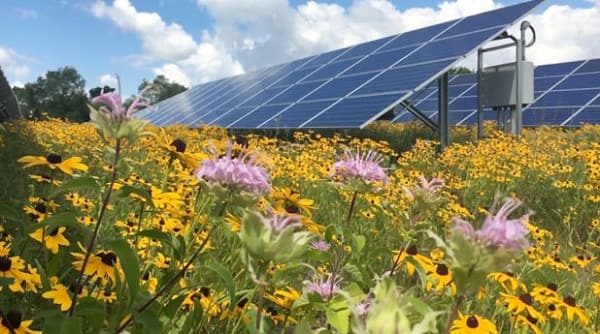Why it makes sense to plant native species around solar systems


Solar arrays convert light from the sun into energy by creating an electrical current. Flowers convert light from the sun into energy through photosynthesis. Rob Davis of Fresh Energy argues these two energy producers make a perfect pair. He recently presented at the Minnesota Solar Congress about how smart siting of solar that includes a mix of flowering plants can make communities more supportive of solar, while providing additional environmental and economic benefits to the system owner.
Bees and other animals, known as pollinators, move pollen between plants as they use the plants as a food source. This pollination process fertilizes the plant, helping it to grow fruits. We rely on pollination to ensure good food harvests. This relationship is threatened by our use of pesticides; while they protect crops from being eaten, they also harm those animals that help crops grow in the first place.
Davis posits that solar installations are perfect locations for native plants, and the pollinators that come along with them, to grow. Typically, solar arrays are landscaped with either gravel or grass. While this is lowest upfront cost option, it can often draw aesthetic opposition from the local community. Landscaping with native plants provides more than just a visual benefit. The right mixture of plants can improve the soil around the system by retaining groundwater and adding nutrients to the soil.
Because of this, farmlands that add native plant habitats around their system will see a financial return from their initial investment. Their revenues increase directly because of the installation of pollinator habitat. That’s even after subtracting out the implementation costs for planting and maintaining the pollinator-friendly habitat.
In 2016, Minnesota passed a law that sets forth voluntary land management practices for solar developers to follow. The specific requirements are laid out in this form. It provides a good road map for how to pair two energy producers, solar and plants, together.
